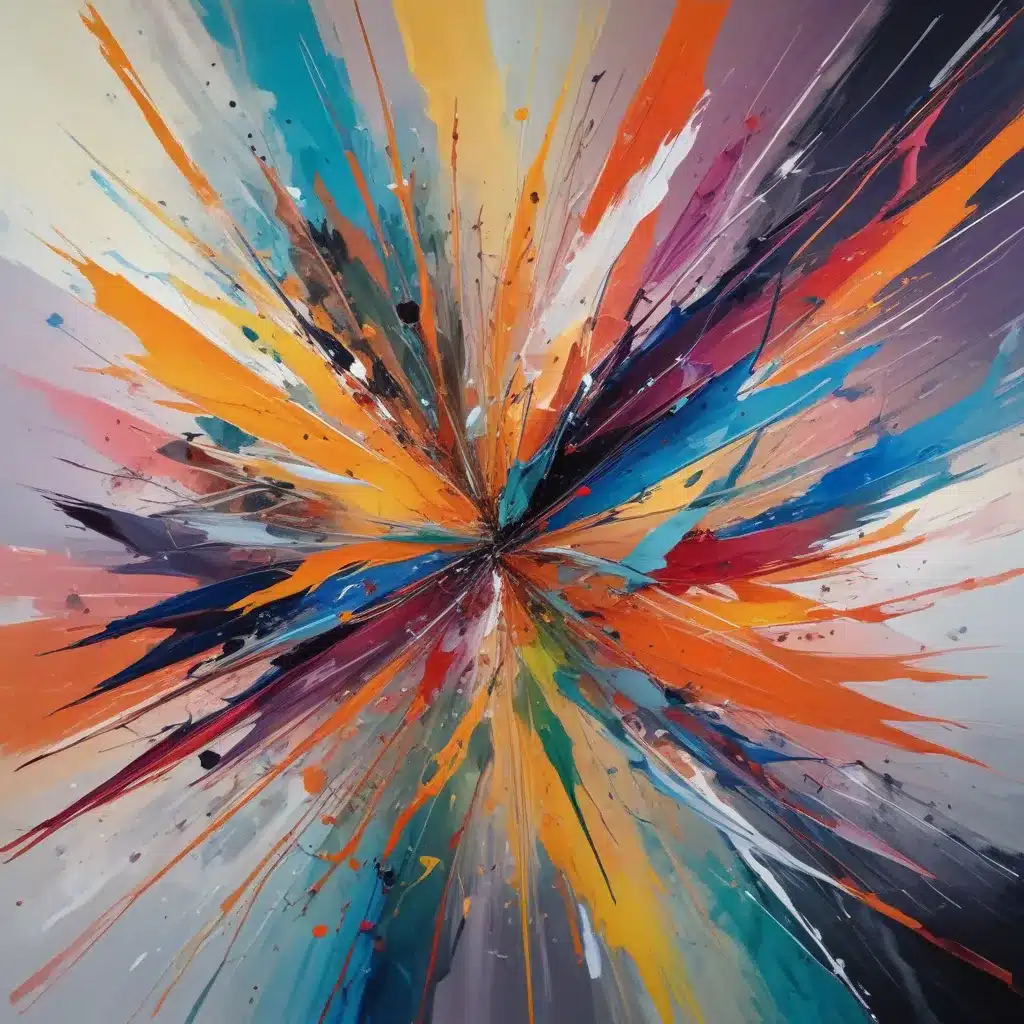
In the ever-evolving landscape of contemporary art, the mastery of dynamic compositions that capture a sense of energy and movement has become a hallmark of the most captivating abstract paintings. Whether you’re drawn to the vibrant, gestural expressions of abstract expressionism or the mesmerizing optical illusions of kinetic art, the ability to infuse your acrylic paintings with a palpable sense of motion can elevate your work and captivate your audience.
Acrylic Painting Techniques for Kinetic Compositions
Acrylic paint, with its versatile and fluid nature, is an ideal medium for exploring the realm of kinetic compositions. Unlike the slow-drying properties of oil paints, acrylics allow for a more immediate and responsive approach, enabling you to capture the momentum and spontaneity of your creative process.
Expressive Brushwork
One of the foundational techniques for creating a sense of movement in your acrylic paintings is expressive brushwork. Embrace bold, sweeping gestures that convey a sense of energy and vitality. Experiment with different brush sizes, strokes, and techniques, such as:
- Loose, Gestural Strokes: Use a large, flat brush to apply paint with broad, energetic movements, allowing the paint to flow and blend on the canvas.
- Directional Marks: Utilize a range of brushes to make purposeful, directional marks that guide the viewer’s eye through the composition.
- Layered Textures: Build up layers of paint with varied brushstrokes, creating a sense of depth and movement.
Palette Knife Techniques
In addition to expressive brushwork, the use of a palette knife can be a powerful tool for generating kinetic compositions. The knife’s sharp edge and ability to manipulate paint in a more tactile, sculptural manner can lend a dynamic, almost sculptural quality to your paintings. Try techniques such as:
- Scraping and Dragging: Use the knife to scrape, drag, and push the paint across the canvas, creating linear patterns and rhythmic movements.
- Impasto Application: Apply thick, impasto layers of paint with the palette knife, allowing the texture and physicality of the medium to convey a sense of movement.
- Blending and Mixing: Utilize the knife to blend and mix colors directly on the canvas, creating soft, blurred edges that suggest a sense of flux and fluidity.
Dripping and Pouring
Embracing the inherent fluidity of acrylics, you can also experiment with dripping and pouring techniques to infuse your compositions with a kinetic energy. By allowing the paint to flow and drip across the canvas, you can capture the natural movement and unpredictability of the medium. This approach can be particularly effective when working with acrylic inks or thinned paint, which lend themselves to more fluid, organic forms.
Capturing Dynamism Through Color and Composition
Beyond the technical application of the paint, the strategic use of color and composition is crucial for creating a sense of dynamism and movement in your abstract acrylic paintings.
Color and Rhythm
Vibrant, contrasting colors can imbue your compositions with a pulsating rhythm and sense of energy. Experiment with complementary hues that create visual tension and a sense of movement. Equally, the strategic use of gradients and color transitions can suggest a feeling of flux and transition across the canvas.
Compositional Strategies
The arrangement of shapes, lines, and forms within your composition can also contribute to a kinetic quality. Employ asymmetrical or diagonal compositions that guide the viewer’s eye through the painting, creating a sense of momentum and energy. Incorporate overlapping forms and intersecting lines to suggest depth and a sense of movement through the picture plane.
Cultivating Creative Inspiration
Nurturing creative inspiration is essential for translating your artistic vision into dynamic, kinetic compositions. Draw from a variety of sources to fuel your explorations:
Observational Drawing
Begin by honing your skills in observational drawing, capturing the movement and energy of the world around you. Sketch people in motion, study the flow of nature, or observe the rhythmic patterns of everyday objects. Translate these studies into your acrylic painting process, infusing your work with a sense of vitality and realism.
Conceptual Ideation
Engage in conceptual ideation, exploring themes and ideas that resonate with a sense of dynamism and kinetic energy. Draw inspiration from the rhythms of music, the principles of physics, or the fluid movements of dance. Allow these conceptual starting points to guide the development of your compositions.
Experimental Explorations
Embrace an experimental mindset, continuously pushing the boundaries of your painting practice. Experiment with new techniques, unexpected materials, and unconventional approaches. Allow yourself to play, take risks, and discover the unexpected within the realm of kinetic compositions.
Integrating Art Theory and Principles
As you delve into the creation of dynamic, kinetic-inspired acrylic paintings, it’s valuable to consider the underlying art theory and design principles that can inform and elevate your work.
Color Theory
Revisit the fundamentals of color theory, exploring how contrasting hues, complementary relationships, and chromatic harmonies can contribute to a sense of movement and energy within your compositions. Experiment with the strategic use of warm and cool tones, as well as high-contrast and muted palettes.
Compositional Balance
Strive for a balanced compositional arrangement, even as you introduce a sense of dynamism and movement. Employ principles such as symmetry, asymmetry, and golden ratio to create a visually harmonious yet energetic painting.
Texture and Layering
Embrace the textural qualities of acrylic paint, utilizing techniques like impasto, glazing, and scumbling to create a sense of depth and dimensionality within your compositions. Experiment with the interplay of smooth and rough surfaces to suggest a feeling of kinetic energy.
By integrating these artistic principles and techniques, you can elevate your acrylic painting practice and create captivating, kinetic-inspired compositions that leave a lasting impression on your audience. Remember, the journey of mastering dynamic, movement-infused abstract painting is an ongoing exploration, filled with opportunities for growth, experimentation, and creative self-expression.
For more insights and inspiration on contemporary painting techniques, be sure to visit Pencil and Paint Muse – your go-to resource for emerging artists seeking to elevate their creative practice.
Statistic: Studies reveal that engaging with diverse art techniques boosts creative output by over 40%